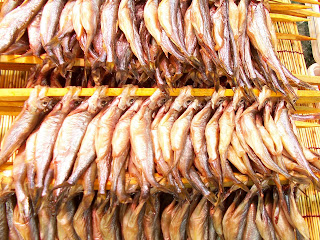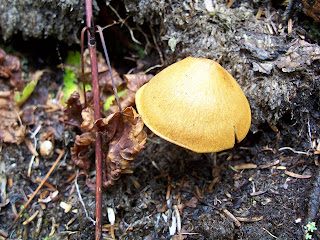
Not many herring left, but fishing and tourism still keep Otaru prosperous. We ate 'Viking' ('all-you-can-eat') sashimi and jingisukan.
(Fish market, Chuo-dori, Otaru.)

The bay where the herring were dragged in.

Early 1900s image of the bounty. (Aoyama Villa.)

Fishermen here still use the traditional glass floats. The glass-blowing industry still survives, having expanded to ornaments and jewellery, trading on the "Venice of Japan" promotion.


The villa built for herring millionaire Masakichi Aoyama.

40 carpenters built the mansion from 1917 - 1923 using Zelkova and sugi (Japanese Cedar.) Alcoves in each room were of a different rare hardwood.

Detail of a screen. Screens and sliding doors (shoji & fusama) were decorated by Master painter Gyokudo Kawai.
Otaru is a small historical port on the Sea of Japan about 40 mins NW of Sapporo by train. The city gained wealth through its herring industry in the early 1900s. Millions of tons of fish were hauled from the sea, employing thousands and making a small number exceptionally wealthy. In a single night one team (
toh) of 25 - 100 fishermen could net up to 600 000 herring. The record, unsurpassed, goes to the season's first haul in 1913 which yielded 560 ooo tons!
For a time Otaru was a major port and financial hub of Ezo.
We spent the morning strolling the old canal and wharf, then lunched at a restaurant in one of the many renovated old stone warehouses.
In the afternoon we caught a local bus to the bay where the original fishermen got rich.
The Aoyama family was one of the city's 3 leading herring tycoons and their wealth lasted 3 generations. Even by today's standards the home is a mansion. Built of the finest timbers, double-glazed and filled with the finest furnishings and works of art from both the East and the West, the structure took six years to complete by 1923, when it must have been the last word in luxury.
We're lucky the house is well-preserved and open to the public - the family's fortune waned as the herring catch inevitably declined.
 Koshiro is the closest city to the Kushiro Wetlands and the Shitsugen National Park we want to visit. It also has the BEST seafood...
Koshiro is the closest city to the Kushiro Wetlands and the Shitsugen National Park we want to visit. It also has the BEST seafood...


















































